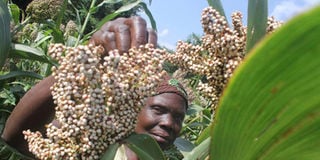Bridging gap to market key to harnessing potential of finger millet farming in Kenya

A farmer examines finger millet in her farm in Sidho, Muhoroni of Kisumu County.
What you need to know:
- Despite its nutritional richness and resilience to environmental challenges, finger millet farming faces a critical obstacle - limited access to markets
- Revitalising finger millet farming demands a holistic approach to tackling systemic challenges
- Finger millet's ability to thrive with minimal water requirements makes it particularly well-suited to regions experiencing water scarcity
Finger millet, the "lost crop of Africa," stands out as a nutritional powerhouse and a potential catalyst for economic growth in Kenya. Despite its nutritional richness and resilience to environmental challenges, finger millet farming faces a critical obstacle - limited access to markets. Addressing this hurdle will harness the crop's potential and uplift farmers.
Finger millet has been a staple in Kenya for centuries. Its nutritional profile makes it a valuable asset in combating food insecurity exacerbated by climate change. Rich in protein, fiber and essential nutrients, finger millet offers nutritious food for communities vulnerable to malnutrition. As climate-related disruptions threaten food production and access, prioritizing resilient crops like finger millet becomes imperative for safeguarding food security and ensuring the well-being of Kenya's population.
Its robust nature enables it to thrive in diverse agro ecological zones, from the highlands to the lowlands, making it a dependable option for farmers grappling with the uncertainties brought about by climate change. In a landscape where traditional staples struggle to withstand extreme weather events, finger millet stands tall as a resilient and sustainable solution.
Finger millet's ability to thrive with minimal water requirements makes it particularly well-suited to regions experiencing water scarcity, a growing concern in many parts of Kenya. As water resources become increasingly scarce due to climate variability and population pressure, crops like finger millet offer a lifeline to farmers seeking alternatives less dependent on irrigation.
By cultivating finger millet, farmers not only mitigate the risks associated with water scarcity but also contribute to the conservation of water resources, thereby promoting long-term sustainability in agriculture.
Yet, finger millet cultivation in Kenya remains underexploited, primarily due to challenges in accessing markets, especially for smallholder farmers. Rural areas where finger millet predominates suffer from inadequate infrastructure and market linkages. Poor road networks and limited transportation facilities make it difficult for farmers to transport their produce to urban centres or trading hubs, forcing them to settle for lower prices locally, perpetuating poverty cycles.
Moreover, the misconception of finger millet as a "poor man's crop" dampens its market demand compared to more popular grains like maize and wheat. Consumer awareness about finger millet's health benefits and culinary versatility remains low. Efforts to promote finger millet as a nutritious staple and develop value-added products could boost its market appeal and open new avenues for farmers.
Another significant challenge is the lack of supportive policies and institutional frameworks for market access. Government intervention is crucial in incentivising finger millet cultivation and establishing market linkages through infrastructure development and information systems. Policies supporting research, extension services, and access to credit can empower farmers and enhance their livelihoods.
Strengthening farmer cooperatives and producer groups can amplify collective bargaining power, enabling bulk sales and reducing reliance on exploitative brokers. Leveraging technology can revolutionize the finger millet value chain, providing farmers with real-time market information and facilitating access to weather forecasts and agronomic advice. Additionally, agri-tech startups can innovate value-added products, catering to diverse consumer preferences and boosting market demand.
Revitalising finger millet farming demands a holistic approach to tackling systemic challenges.
Investment in infrastructure, consumer awareness, policy support, and technology integration are pivotal. With concerted efforts from government, private sector, research institutions and development partners, Kenya can unlock new opportunities, ensuring food security, nutrition, and economic growth through finger millet farming.
Mr Njoroge is the Kenya country coordinator of Farm to Market Alliance (FtMA).




